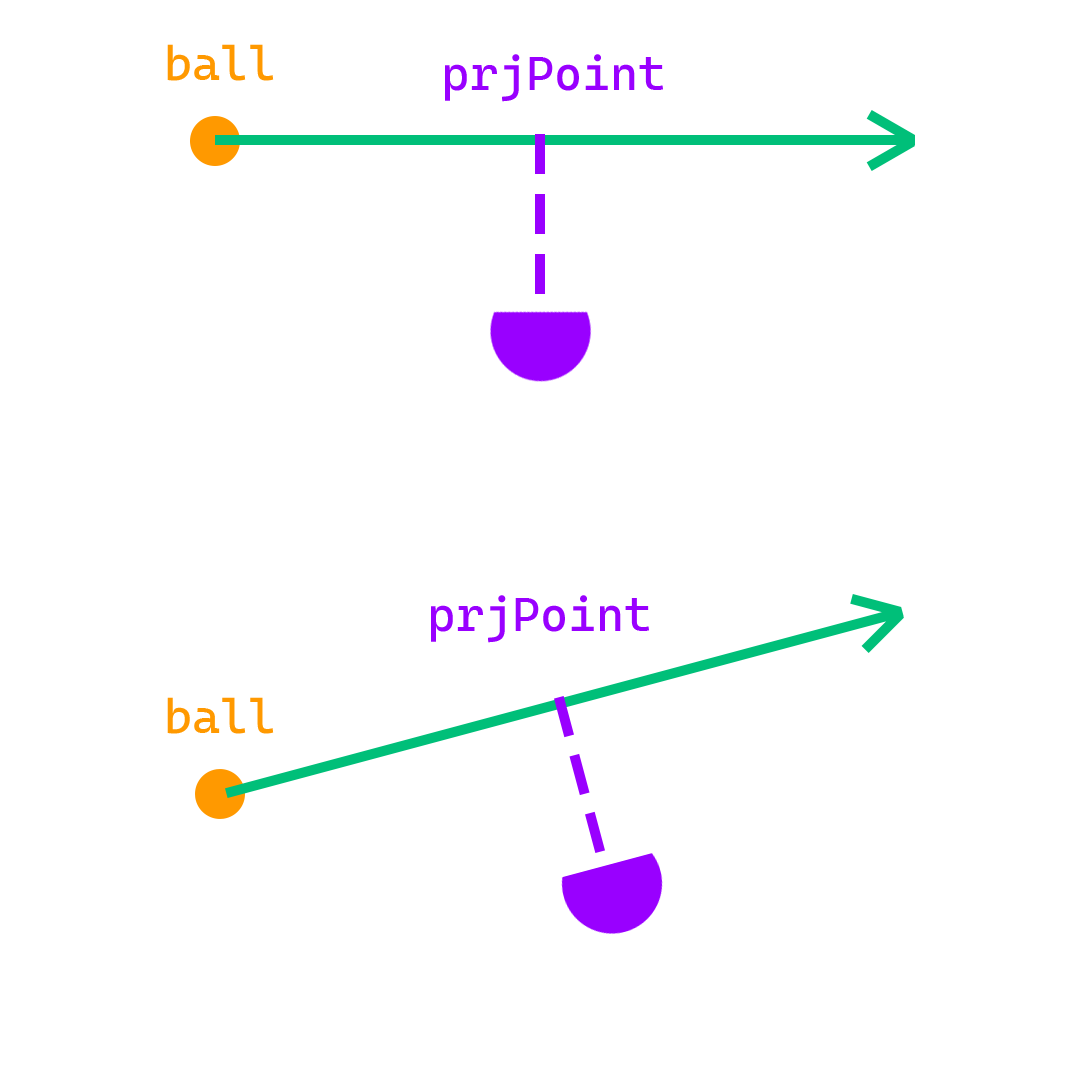数据类型相关
大约 5 分钟
写在前面
本篇主要介绍在
Rocos/share/geomotry.h中定义的类(class)。内容 部分提供了部分类型的私有成员仅用于方便理解用。
构造 部分的 lua 部分传入参数的类型可以参考 cpp 部分。
常用数据类型
CVector
二维向量,常用于表示速度等。
内容
double _x向量的 x 值。double _y向量的 y 值。
构造
lua
-- 传入坐标 x,y 值
local vel = CVector(x, y)
cpp
// 等效于 CVector(0, 0)
CVector()
// 传入坐标 x,y 值
CVector(double x, double y)
// 传入另一个向量
CVector(const CVector &v)
- 常用方法
double mod()返回向量的模。double mod2()返回向量的模的平方。double dir()返回向量的角度。double theta(const CVector &v)返回自身到给定向量的夹角。double x()获取 x 值,还有返回 y 值的y()。CVector operator+(const CVector &v)返回当前向量加上传入向量。CVector operator-(const CVector &v)返回当前向量减去传入向量。CVector operator*(double a)返回当前向量的x, y乘上a。double operator*(CVector b)返回当前向量的向量点乘。CVector operator/(double a)返回当前向量的x, y除以a。CVector operator-()返回当前向量的负。
lua
-- 使用方法
local vel = CVector(x1, y1)
-- mod()
local velMod = vel:mod()
-- dir()
local veldir = vel:dir()
-- x,y
local vel1X = vel:x()
local vel1Y = vel:y()
cpp
// 使用方法
CVector vel = CVector(x, y)
// mod()
double velMod = vel1.mod()
// dir()
double veldir = vel.dir()
// x,y
double velX = vel.x()
double velY = vel.y()
CGeoPoint
二维的坐标点。
内容
double _x坐标的 x 值。double _y坐标的 y 值。
构造
lua
-- 传入坐标 x,y 值
local point = CGeoPoint(x, y)
cpp
// 构造出 (0, 0)
CGeoPoint()
// 传入坐标 x,y 值
CGeoPoint(double x, double y)
// 传入另一个坐标点
CGeoPoint(const CGeoPoint &p)
- 常用方法
double x()获取 x 值,还有返回 y 值的y()。double dist(const CGeoPoint &p)返回传入坐标与当前坐标的距离。double dist2(const CGeoPoint &p)返回传入坐标与当前坐标的距离的平方。CGeoPoint midPoint(const CGeoPoint &p)返回传入坐标与当前坐标的中点坐标。bool operator==(const CGeoPoint &rhs)返回当前坐标与传入坐标是否相同。CGeoPoint operator+(const CVector &v)返回传入坐标与当前坐标的和。CVector operator-(const CVector &v)返回传入坐标与当前坐标的差。CGeoPoint operator*(const double &a)返回当前坐标的x, y乘上a。
lua
-- 使用方法
local point1 = CGeoPoint(x1, y1)
local point2 = CGeoPoint(x2, y2)
-- 我们仔细观察可以发现两个 CGeoPoint 相减之后的类型是 CVector
-- 所以我们相减过后可以调用 CVector 的方法
-- 例如 mod()
local mod = (point1 - point2):mod()
-- dist()
local dist = point1:dist(point2)
-- 其实 mod == dist
cpp
// 使用方法
CGeoPoint point1 = CGeoPoint(x1, y1);
CGeoPoint point2 = CGeoPoint(x2, y2);
// 我们仔细观察可以发现两个 CGeoPoint 相减之后的类型是 CVector
// 所以我们相减过后可以调用 CVector 的方法
// 例如 mod()
double mod = (point1 - point2).mod();
// dist()
double dist = point1.dist(point2);
// 其实 mod == dist
CGeoLine
直线(区别于线段)。
内容
CGeoPoint _p1直线的第一个坐标点。CGeoPoint _p2直线的第二个坐标点。
构造
lua
-- 传入直线的起点和直线的方向
local line1 = CGeoLine(point1, point2)
local line2 = CGeoLine(point, dir)
cpp
CGeoLine() {}
// 传入直线的两个坐标
CGeoLine(const CGeoPoint &p1, const CGeoPoint &p2)
// 传入直线的起点和直线的方向(射线)
CGeoLine(const CGeoPoint &p, double angle)
常用方法
- 返回投影点坐标。
cppCGeoPoint projection(const CGeoPoint &p)关于投影点坐标:

关于投影点坐标 CGeoPoint point1()返回点 1。CGeoPoint point2()返回点 2。bool operator==(const CGeoLine &rhs)返回当前实现是否与传入直线相同。
lua
-- 使用方法
local line = CGeoLine(point1, point2)
-- projection()
local projectionPos = line:projection(point3)
-- point1,point2
local point1 = line:point1()
local point2 = line:point2()
cpp
// 使用方法
CVector vel = CVector(x, y)
// mod()
double velMod = vel1.mod()
// dir()
double veldir = vel.dir()
// x,y
double velX = vel.x()
double velY = vel.y()
CGeoLineLineIntersection
直线与直线的交点。
内容
bool _intersectant两条直线是否相交。CGeoPoint _point两条直线的交点。
构造
cpp
// 传入两条直线(CeoLine)
CGeoLineLineIntersection(const CGeoLine &line_1, const CGeoLine &line_2)
- 常用方法
bool Intersectant()两条直线是否相交。CGeoPoint IntersectPoint()两条直线的交点。
CGeoSegment
线段(区别于直线),继承自直线。
内容
CGeoPoint _start线段的起点。CGeoPoint _end线段的终点。
构造
lua
-- 传入线段的起点和终点
local segment = CGeoSegment(point1, point2)
cpp
CGeoSegment() {}
// 传入线段的起点和终点
CGeoSegment(const CGeoPoint &p1, const CGeoPoint &p2)
- 常用方法
bool IsPointOnLineOnSegment(const CGeoPoint &p)直线上的点是否在线段上。CGeoPoint segmentsIntersectPoint(const CGeoSegment &p)和传入线段的交点,如果没有交点会返回CGeoPoint(9999, 9999)。double dist2Point(const CGeoPoint &p)返回传入点到当前线段的距离。double dist2Segment(const CGeoSegment &s)返回传入线段到当前线段的距离,如果相交返回0.CGeoPoint start()返回起点,还有返回终点的end()和返回中点的center()。
常用数据类型的方法
提示
根据这里所介绍的,该板块的这些常用方法的适用范围不仅仅只有演示中的数据类型,可以自行实践。
mod()取两个坐标之间的模长。用法示例:
lualocal distance = (point1 - point2):mod()dir()取两个坐标的方向。用法示例:
lualocal direction = (point1 - point2):dir()
总结
- 在 lua 中我们想要使用几何相关的数据类型及其方法,可以去
Rocos/Core/src/LuaModule/geometry.pkg中查阅,并根据具体的定义去正确使用。 - c++ 则需要到相应的
Rocos/share/geometry.h和Rocos/share/geometry.cpp文件中查阅。